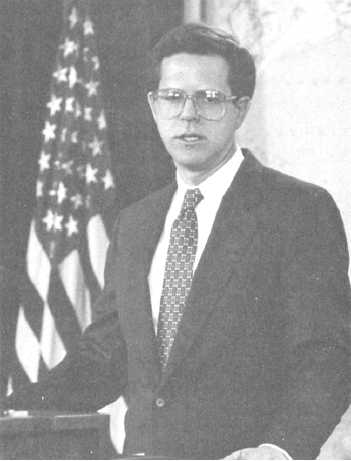Helene C. Stikkel
Figure 3-2.—A speech story features something not officially dis-
closed before.
THE SPEECH STORY
LEARNING OBJECTIVE: Recognize the
fundamentals of writing a speech story.
Often, Navy JOs become jittery when first assigned
to cover a speech story because they do not think they
can get the facts or put them into story form. Actually,
any writer who knows the fundamentals of news
reporting can write a speech story.
First, the writing of a speech story resembles any
other news story in many aspects. The most important
fact, the climax of the story, goes in the lead. This
usually means that the most important thing the speaker
said goes in the lead. Occasionally, the most important
fact may be something unusual — audience reaction, for
instance — but generally, what the speaker said, either
in quote or summary, is the feature.
The Secretary of Defense (SECDEF) may cover
four major topics during an address, but the main point
may have been the disclosure of a pay increase for all
military personnel. This fact goes into the lead as
depicted in the following text:
“All active-duty military personnel
will get a four percent pay increase
January 1,” said Defense Secretary
Justin N. Case in a speech before the
National Press Club last night.
Merely that a speaker appeared before an audience
has very little story merit. The speaker must say
something newsworthy — something that has not been
officially disclosed before. This normally happens when
a speaker appears before the media in a news conference
(fig. 3-2).
The subject title of the speech is rarely important
enough to become part of the lead. Speech titles are
usually catch phrases that reveal very little about what is
the most important part of the story. For example, when
the President of the United States speaks, the lead
features what he said in the following manner:
“The president, in a major speech
tonight, called for another tax cut. ...”
If the writer started off with the information that the
president spoke, no one would have much insight into
the importance of the speech.
In structuring the speech story lead, include what
was said and who said it. When and where it was said
can usually be included within the lead, if the lead does
not become too cumbersome. If it does, include them in
the second paragraph.
Usually a direct quote lead will not do, for most
speakers do not summarize their talk in one sentence.
Thus the writer should paraphrase the lead, summarizing
what the speaker said in one brief sentence.
PARAPHRASING
When you paraphrase, you must be careful to keep
the speaker’s meaning. Do not quote out of context; that
is, do not quote a sentence that gives a wrong impression
when used alone.
For example, a reporter hears the president say, “I
haven’t decided to seek reelection. However, I have
instructed my staff not to be too hasty in looking for new
employment.” If the journalist had quoted that first
sentence alone, he would have given the impression that
the president was not planning to run for another term in
office, when that obviously was not what the president
meant.
3-9


